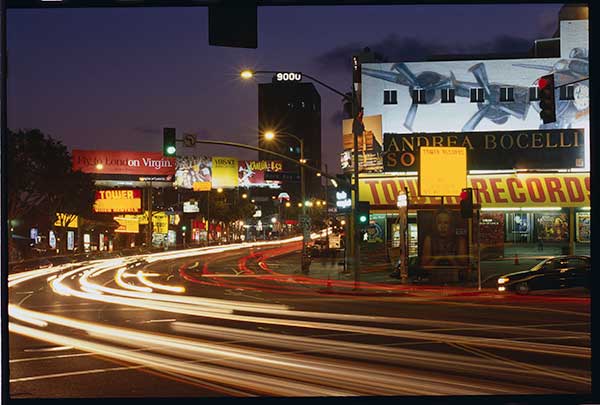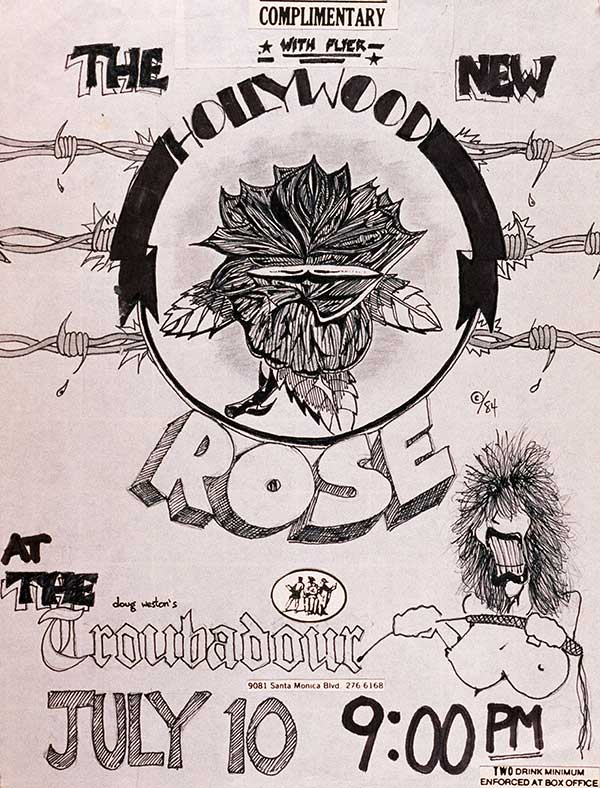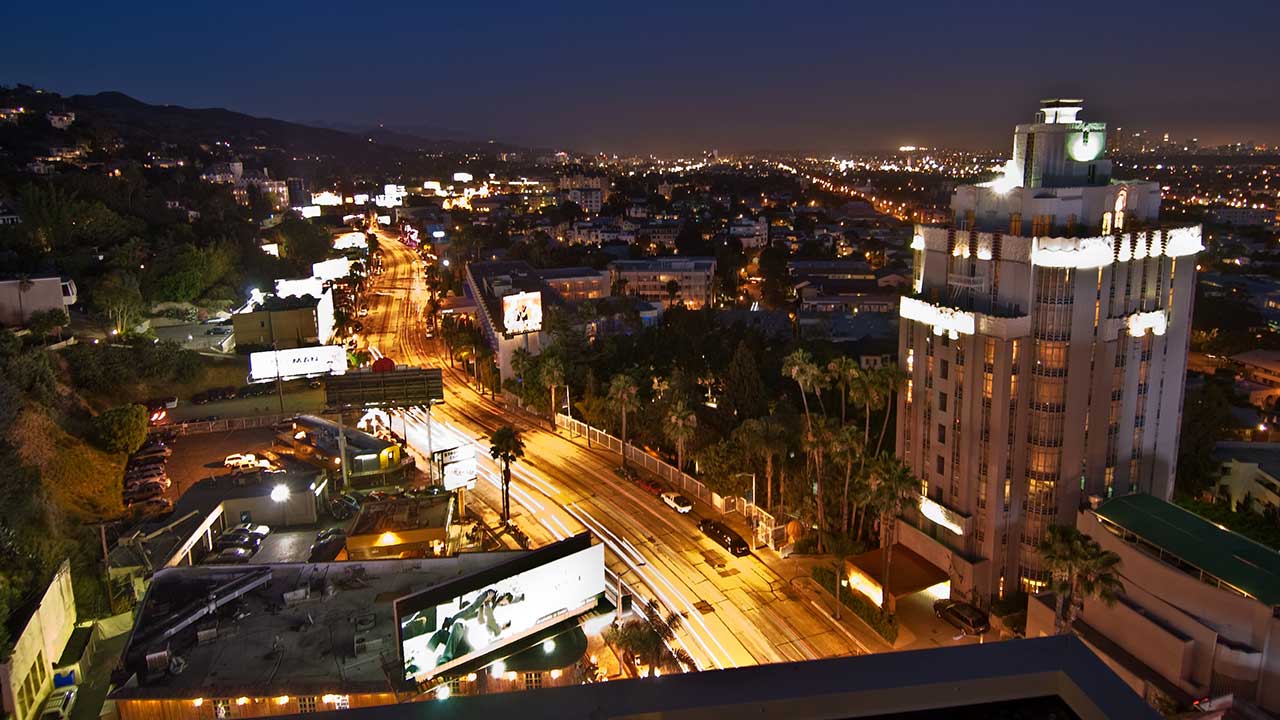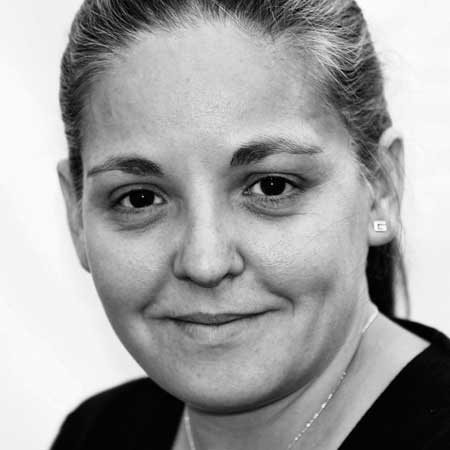Loosely translated, Los Angeles means the City Of Angels. But it’s been called many things in its time: a city of dreams; a city of destruction; Guns N’ Roses even famously immortalised it as Paradise City. And all these descriptions are entirely apt to one degree or another.
Over the years Los Angeles has seen its fair share of both angels and devils, and many of them with a shared passion for rock’n’roll. It’s a city without a centre, a fragmented place held together by freeways and thruways, full of misfits and larger-than-life characters.
It’s the way it’s always been. And probably the way it always will be.

From the early 50s scene of surf bands that eventually morphed into the heady music that The Doors’ Jim Morrison turned into an art form in the 60s, LA’s Sunset Boulevard has always appeared on the radar as the ultimate place for misbehaving rock stars to congregate.
Fondly (or sometimes not so fondly) referred to as Sunset Strip, it’s the mile and a half of avenue that links Hollywood with the moneyed, upmarket neighbourhood of Beverly Hills. If you’re looking for definition, the Strip’s unofficial boundaries run to Crescent Heights Boulevard (to the east) and Doheny Drive (to the west). But what’s so special about this little corner of the Paradise City?
Well, this section of wide-avenued West Coast America houses a huge percentage of the famous rock clubs you’ve ever heard or read about in rock folklore: The Whisky A Go Go, The Cathouse, The Roxy… It’s also the home of Sunset Strip Tattoo, the place where any self-respecting established (or wannabe) rocker goes to get some serious ink into their skin. They’ve all gone under the needle there, from Mötley Cruë to Guns N’ Roses to Billy Idol to nouveau wannabe bad boy Robbie Williams.
Blink and you miss it, but you’ll find it nestling among hotels across the road from the famous Hyatt House Hotel – the place nicknamed The Riot House in the 70s for all the right reasons. The Hyatt House was the place where all the rock stars would gather when they passed through town – everyone from Led Zeppelin to The Who.
Televisions got thrown through its windows; motorcycles were be ridden indoors; inappropriate acts took place around the pool. Little Richard lived there full-time. Blasting out and causing all sorts of chaos in the late 70s, Van Halen were the ultimate home-town heroes, arguably the first in a rash of party-hard rock’n’rollers that spawned the LA scene of the 80s. Four guys who lived life to the max.

Although Van Halen frontman David Lee Roth was a transplanted New Yorker, he soon morphed into the ultimate California boy – the male equivalent of the good-time party girls he sang about with such enthusiasm in the Beach Boys song he co-opted in later years, California Girls.
Arriving in Los Angeles in the mid-70s, ostensibly to go to college, Roth soon hooked up with brothers Alex and Edward Van Halen and bassist Mark, Anthony. And upon the release of their debut record in 1978, things kicked off. And Los Angeles was always the starting point.
“It’s like, anything you desire you can find here – whatever your vice, whatever your sexual ideals. Whatever somebody else can’t do in his nine-to-five job, I can do in rock’n’roll,” a delighted David Lee Roth told Rolling Stone years ago. “I guess what I’m saying, man, is that I’m proud of the way we live. Not so much because of the records we sell or the money we make, but because of the party we’re going to have afterward to celebrate all that.”
Parties were on everyone’s agenda back then. It was all down to who could throw the wildest, most out-of-control bash. This was long before rock musicians got wise and healthy and had nothing stronger than mineral water and fresh fruit on their backstage tour rider. And Van Halen’s parties were known to be among the best in the business.
To that end, David Lee Roth was the first rock star to enlist the help of a full-time ‘Entertainment Officer’ while his band were out on the road. The parties were huge, with no shortage of beer, Jack Daniel’s and girls. And for Roth girls were the most important ingredient.
"Most of what I do is because of girls. If girls didn’t exist I wouldn’t have this job, I wouldn’t bother with music. I wouldn’t even bother with breakfast,” Dave told Classic Rock. “My fantasies were always the girl next door. We started to see evidence of the professional groupie in the early eighties and, alarmingly, these girls bore a striking resemblance to Mötley Crüe. For me, the best groupies were the homecoming queens who were out on a lark; the preacher’s daughters out for a wild night.”
The wild nights were coming thick and fast. Roth and the rest would have their fill of girls, drink and dope, and go on to play another day.
While the main ingredients of Van Halen's parties of the late 70s and early 80 consisted of mostly booze and girls, other musicians were arriving in Los Angeles hell-bent on a far more destructive journey.
Steven Adler had lived in Los Angeles since he was 12 years old. By the early 80s he was still at school, but realising that his ambitions were leaning towards music. Adler was a drummer, and one of his friends at school was a misfit kid, born in England. His name was Saul Hudson. Today we know him as Slash.
“We’d dip school nearly every day,” Adler told Classic Rock’s Mick Wall. “Me and Slash would walk up and down Sunset and Hollywood Boulevards, and each day we had this thing where we’d take a different type of alcohol and we’d walk up and down, up and down, and what we’d be talking about was how we’d be living when we were rock stars.
"It was like this dream that I always knew would come true. We’d go out and meet older women, who would take us back to their Beverly Hills homes. They’d give us booze, coke, they’d feed us, really."
Slash and Adler lived the street urchin life until they got it together enough to team up with some friends to form a band. They hooked up with a band called Hollywood Rose, who had a frontman called Axl. The rest, as they say…
Another band that seemed to personify the hedonistic glamour of 80s Los Angeles was Poison. Four larger-than-life characters who were transplanted from the east coast – all big hair, Day-Glo clothing, and big songs about girls, sunshine and parties.
“We didn’t want to be anything other than ourselves. We wanted it all – the cars, the girls, the fame, the money… Music had kind of sucked. It had no energy. But we were young and we were into the whole rock star ideal, and that’s what we pursued,” frontman Bret Michaels recalled in 2001.
“And in LA, the girls are amazing looking, you know,” Michaels continued. “If you were from Pennsylvania, it was just amazing! It was hot, and there were all these guys trying to get their thing going too. I mean, we’d have our flyers and we’d be handing them out on the street, and Axl Rose would be there too, and he’d be like, ‘Hey come and check us out, we’re called Hollywood Rose…’ It was just a great time, really.”

It seemed that all the bands plying their trade on Sunset Strip were somehow inextricably linked; it’s possible to play a twisted version of Six Degrees Of Separation – the parlour game that seeks to prove that any two people can be linked through various means, however nebulous – with any recognisable LA band.
But for the LA set, the links are solid. Just consider a few of them: GN’R’s Slash nearly ended up in Poison; Tracii Guns of LA Guns played with Axl, and gave his surname to Axl’s new band when Hollywood Rose imploded; Mötley Crüe and GN’R are linked thanks to a feud; Nikki Sixx played with Tracii Guns in Brides Of Destruction…
The link between Mötley Crüe and Ratt is stained with blood and steeped in tragedy. Both bands began their rise to the top at around the same time. Both bands had nailed the Hollywood bad-boy image – all tattoos, ripped jeans, preposterously big hair, and a snarling air of danger that seemed to precede everywhere they ended up. Crüe bassist, godfather and spiritual leader Nikki Sixx seems to embody the idea of the quintessential LA rocker.
Tattooed, street-smart, and effortlessly exuding cool. Nonetheless, he is not without his battle scars – after all, on one fateful night in 1987 in LA (where else?) Nikki died. Upon returning from a fraught tour of Japan with the Crüe, Nikki chose to stop by his heroin dealer (the same guy who also dealt to Robbin Crosby of Ratt); having narrowly avoided being thrown into a Japanese jail following a bottle-throwing incident that took place on Japan’s world-famous Bullet Train, he needed to cut loose.
But what happened to Nikki on that dealer-visiting night isn’t exactly what he had in mind. Getting high is one thing, killing yourself is another, as Nikki recalls in the band’s infamous autobiography The Dirt.
Nikki: “He rolled up my sleeve, tied off my arm and plunged the Persian into my veins. The heroin raced to my heart, exploded all over my body, and in an instant I was blue. I lost consciousness. When I opened my eyes everything was a blur of light, colour and motion. I was on my back, moving through some kind of corridor. Sounds wooshed in and out my ears, unrecognisable at first until a voice slowly emerged out of the white noise: 'We’re losing him, we’re losing him,' it said.
“Above me everything was bright white. I looked down and realised that I had left my body. Nikki Sixx – or the filthy, tattooed container that had once held him – was lying covered face-to-toe with a sheet on a gurney being pushed by medics into an ambulance.”
Nikki ‘died’ for two minutes, but remarkably lived to tell the tale.
It wasn’t just the drink and the hard drugs that Mötley Crüe enjoyed. Unsurprisingly, girls played a big part in their formative years (and also much later); their documented on-the-road groupie shenanigans are nothing short of outrageous.
Nowadays they might all be married/attached and ‘responsible’, but for a long time it was almost the polar opposite of that. For their huge MTV hit Girls Girls Girls, the Crüe employed some of the Strip’s finest, er, strippers to add a certain je ne sais quoi to the video that was shot to accompany the track.
“We’ve always liked underdogs, as human beings. Strippers are some of the hugest underdogs in the country,” Sixx explains – as if any explanation is necessary. “They have beautiful bodies, they’re a guilty pleasure. Husbands say to their wives: ‘I would never go…’ But the stripper business is worth billions per year. We always loved them.
“It was the ultimate place to go and hang out with beautiful women, drink and do drugs. That was the perfect evening. We’d start off at Tommy’s place, have a couple of shots of Jack and off we’d go. It was sort of a free time.
“And the video represents that sense of freedom and youthfulness. The great thing is, that song will always be played as long as there are strip joints, man.”

With all the bands that were hanging out in the small clubs that littered Sunset Strip, there were always petty rivalries and worse ready to rear their ugly heads, and they often did.
The most infamous of all is the spat that developed between Guns N’ Roses and Mötley Crüe. It’s a case that still hasn’t been resolved to any great degree today. And yes, it involved a girl. Vince’s wife, in fact.
The story goes that Crüe singer Vince Neil’s wife Sharise had been hanging out in a club, and GN’R guitarist Izzy Stradlin started hitting on her. Things escalated, and ended with Neil punching out Stradlin backstage at the MTV Video Music Awards. That’s how the feud began.
Subsequently, a vicious war of words between the two factions raged in the pages of rock magazines, culminating in an invitation from Axl to Vince to meet for a fistfight in the parking lot of Tower Records on Sunset. The showdown never happened. But, according to Neil, the offer is still on the table.
“After Axl chickened out a half-dozen times,” Vince stated, “I went on MTV with a message for him. I said that if Axl wanted to fight me then he should do it in front of the whole world. We’d go three rounds, and then the world would see who the pussy was. But I never heard from Axl. Not that day, not that month, not that year, not that century."
Bitter feuds were not limited to inter-band rivalry, either. Fights were beginning to break out within bands, usually triggered an excess of one substance or another.
Before their 1999 re-formation, Poison were well on their way to self-destruction, as Bret Michaels confessed to Classic Rock. “CC [DeVille, guitarist] was getting fucked-up and I was drinking,” he said. “He’s high, but I’m drunk. We were having rows, he slammed me, I slammed him. I ended up in a fist fight with my best friend – this was my best friend. We kept having really stupid arguments – stuff like his guitar was too loud for me to hear myself sing.”
While Poison have managed to iron out their internal difficulties, the camaraderie that might have existed in the past between fellow Los Angeles bands is not present any more, as a posting by Nikki Sixx on the Brides Of Destruction website made clear when it was hypothesised that Brides would join a Kiss tour that Poison were currently on.
“No way in fucking hell would we [Brides Of Destruction or Mötley Crüe] ever, ever tour with a fucking band like Poison.” Sixx wrote. “We have had talks with Kiss and I told them very clearly that we would not do the tour if they used Poison. That would be the death of us. I will not be attached to that kind of fake bullshit.”
Of all the LA bands that have suffered, though, Ratt really picked up the bum hand when life’s cards were dealt. For much of this century two versions of the band have existed, playing the retro circuit of America, but the excesses of the 80s have taken their toll. The various factions have been in and out of court, and in 2002 guitarist Robbin Crosby succumbed to Aids.
But now, twenty years into a supposedly sanitised new millennium, it’s come full-circle, with Guns N' Roses returning to the stage and Motley Crue booking a huge reunion tour in the wake of the success of the movie version of The Dirt. Hell, GN'R might even release a new album.
Only in Hollywood, eh?
The original version of this feature appeared in Classic Rock 69, June 2004.

